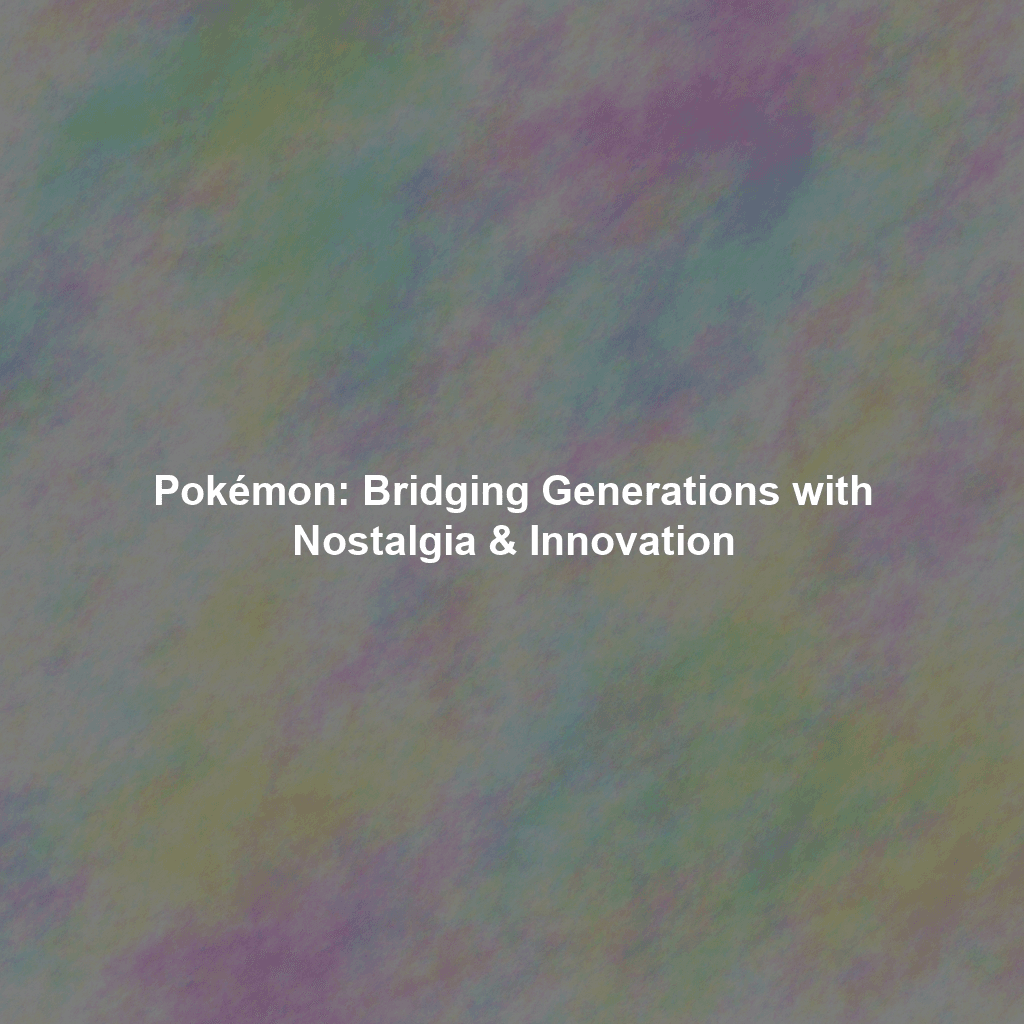Introduction: The Enduring Power of Pokémon
Pokémon. Just the name evokes a wave of memories for millions across the globe. From collecting trading cards to embarking on virtual adventures in the Kanto region, Pokémon has been a cultural phenomenon for over two decades. But its enduring success isn’t solely built on nostalgia. The Pokémon Company International has masterfully navigated the tricky waters of preserving beloved elements while embracing innovation, ensuring the franchise remains relevant and engaging for both long-time fans and a new generation of trainers. This article delves into the strategic balancing act that fuels Pokémon’s multi-platform marketing machine, a concept we explore in-depth in our broader analysis, Beyond Ash & Pikachu: Deconstructing Pokémon’s Multi-Platform Marketing Machine (link to your book/overview article).
Understanding the Nostalgia Factor: Why We Love What We Remember
Nostalgia is a powerful emotion, and Pokémon expertly leverages it. Studies in psychology show that nostalgia provides a sense of comfort, belonging, and continuity, especially during times of uncertainty (e.g., American Psychological Association – “In times of crisis, nostalgia proves to be a powerful tool”). Pokémon taps into this by consistently referencing and reintroducing elements from its early days.
Key Elements of Pokémon’s Nostalgic Appeal:
- The Original 151: Characters like Pikachu, Charizard, and Mewtwo remain iconic and are consistently featured in new games, merchandise, and promotional materials. This provides a familiar anchor for older fans.
- Revisiting Kanto and Johto: Remakes of the original Game Boy games, such as Pokémon FireRed and LeafGreen and more recently Pokémon: Let’s Go, Pikachu! and Let’s Go, Eevee!, and the virtual console releases allow players to relive their childhood adventures with updated graphics and gameplay.
- Throwback Merchandise: Retro-themed merchandise, including plush toys, apparel, and trading cards featuring classic designs, capitalizes on the desire to own tangible pieces of Pokémon history.
- Recurring Characters and Themes: Subtle nods to past events, recurring characters (even in minor roles), and familiar musical themes create a sense of continuity and reward long-term engagement. For example, Professor Oak’s presence as a recurring figure throughout the series, offering guidance or commentary, strengthens the connection to the original games.
By carefully curating and reintroducing these nostalgic elements, Pokémon provides a comforting and familiar experience that resonates with its older fanbase, reminding them of why they fell in love with the franchise in the first place. This emotional connection is a vital component of its lasting success.
Embracing Innovation: Keeping the Game Fresh and Engaging
While nostalgia is crucial, Pokémon’s success isn’t solely reliant on it. To attract new players and keep the franchise relevant, Pokémon consistently introduces innovative features, gameplay mechanics, and world-building elements.
Key Areas of Innovation in Pokémon:
- New Pokémon and Regions: Each new generation introduces a fresh roster of Pokémon with unique designs, abilities, and typings, expanding the world and creating new collecting opportunities. Each region is based on a real-world location providing unique environments and cultural inspiration.
- Evolving Gameplay Mechanics: From Mega Evolution and Z-Moves to Dynamaxing and Terastallizing, Pokémon has consistently introduced new battle mechanics that add depth and strategy to the core gameplay. These innovations keep the competitive scene vibrant and engaging.
- Open-World Exploration: Pokémon Legends: Arceus and Pokémon Scarlet and Violet represent a significant departure from the traditional linear structure of previous games, offering players vast, open worlds to explore and interact with. This shift towards open-world gameplay caters to a modern gaming audience that values freedom and exploration.
- Mobile Gaming and Augmented Reality: Pokémon GO revolutionized mobile gaming by blending the Pokémon world with the real world through augmented reality. This innovative approach introduced the franchise to a new audience and revitalized interest among existing fans. According to Sensor Tower, Pokémon GO has generated billions in revenue, showcasing the power of mobile gaming and AR.
- Expanded Lore and Storytelling: The Pokémon universe has become increasingly rich and complex over the years, with deeper lore, more nuanced characters, and more compelling storylines. The games now explore mature themes and tackle complex narratives, appealing to older players who crave a more sophisticated experience.
These innovations demonstrate Pokémon’s commitment to evolving and adapting to changing gaming trends. By embracing new technologies and gameplay mechanics, Pokémon ensures that the franchise remains fresh, exciting, and appealing to a broad audience. This balance is essential for long-term sustainability.
The Strategic Balancing Act: Marrying Nostalgia and Innovation
The true genius of Pokémon’s marketing strategy lies in its ability to seamlessly integrate nostalgia and innovation. It’s not about choosing one over the other; it’s about finding the perfect equilibrium that satisfies both veteran fans and newcomers.
Examples of Successful Integration:
- Remakes with a Twist: Remakes like Pokémon Omega Ruby and Alpha Sapphire and Brilliant Diamond and Shining Pearl faithfully recreate the original games while adding new features, such as Mega Evolution and updated graphics. This allows players to experience the nostalgia of the original while enjoying modern gameplay enhancements.
- Nostalgic Characters in New Settings: Characters like Red and Blue, the protagonists of the original games, make cameo appearances in later titles, providing a nostalgic connection for older fans while introducing them to a new generation of players.
- Pokémon GO’s Selective Nostalgia: While Pokémon GO features Pokémon from various generations, it initially focused on the original 151, capitalizing on the nostalgia of the first games. As the game evolved, it gradually introduced Pokémon from later generations, keeping the experience fresh while maintaining the core nostalgic appeal.
This strategic balancing act requires a deep understanding of the Pokémon fanbase and a willingness to take risks. The Pokémon Company International carefully monitors fan feedback and analyzes market trends to determine which nostalgic elements to reintroduce and which innovations to prioritize. This data-driven approach ensures that the franchise remains relevant and engaging for its diverse audience.
Multi-Platform Synergy: Expanding the Pokémon Universe
Pokémon’s success extends far beyond video games. The franchise has built a thriving ecosystem across multiple platforms, including trading cards, anime, movies, merchandise, and mobile apps. This multi-platform approach amplifies the impact of both nostalgic and innovative elements, creating a cohesive and immersive experience for fans of all ages.
Key Multi-Platform Strategies:
- The Anime: The Pokémon anime has been a cornerstone of the franchise for over two decades, introducing new Pokémon, exploring new regions, and expanding the lore. While Ash Ketchum’s journey has concluded, the anime continues with new protagonists and storylines, ensuring that the franchise remains relevant to a new generation of viewers. The anime often reflects elements from the latest games, reinforcing the connection between different platforms.
- The Trading Card Game (TCG): The Pokémon TCG has remained popular for over two decades, with new expansions introducing new Pokémon, mechanics, and strategies. The TCG complements the video games, allowing players to collect and battle with their favorite Pokémon in a physical format. The TCG also incorporates new game mechanics introduced in the video games, such as Mega Evolution and VSTAR Powers.
- Movies and Specials: Pokémon movies and specials offer cinematic adventures that expand the Pokémon universe and introduce new characters and storylines. These films often feature stunning animation and compelling narratives, attracting both long-time fans and newcomers.
- Merchandise and Licensing: Pokémon merchandise, including plush toys, apparel, and collectibles, allows fans to express their love for the franchise in a tangible way. The vast range of merchandise caters to different tastes and budgets, ensuring that there’s something for everyone.
By strategically leveraging multiple platforms, Pokémon creates a synergistic ecosystem that reinforces the brand and engages fans on multiple levels. This multi-platform approach is a key driver of Pokémon’s long-term success.
Lessons Learned: Key Takeaways for Marketers
Pokémon’s success in balancing nostalgia and innovation offers valuable lessons for marketers in any industry.
Actionable Insights for Marketers:
- Understand Your Audience: Know what your audience values and what emotional connections they have with your brand or product.
- Don’t Be Afraid to Innovate: Embrace new technologies and trends to keep your brand fresh and relevant.
- Respect Your Heritage: Acknowledge and celebrate your brand’s history and legacy.
- Find the Right Balance: Carefully integrate nostalgic elements with innovative features to appeal to both long-time customers and new audiences.
- Listen to Feedback: Continuously monitor customer feedback and adjust your strategy accordingly.
- Build a Community: Foster a strong community around your brand to create a sense of belonging and loyalty. Pokémon does this incredibly well, fostering online and offline communities around gaming, trading cards, and general fandom.
By applying these principles, marketers can build brands that resonate with multiple generations and achieve long-term success. Pokémon serves as a powerful example of how to navigate the complexities of nostalgia and innovation while building a thriving and enduring franchise.
Ready to delve deeper into Pokémon’s marketing strategies? Contact us to learn more about our “Beyond Ash & Pikachu” analysis and how we can help you apply similar principles to your own brand.
Conclusion: The Future of Pokémon
Pokémon’s journey is far from over. With new games, anime series, and merchandise constantly being released, the franchise shows no signs of slowing down. By continuing to embrace innovation while honoring its rich history, Pokémon is well-positioned to capture the hearts and minds of future generations of trainers. The key will be maintaining that delicate balance, ensuring that the magic of Pokémon continues to resonate for years to come. As we continue to deconstruct the Pokémon marketing machine in our future analyses, we’ll explore specific campaigns, platform-specific strategies, and emerging trends that will shape the future of this iconic brand.
 Skip to content
Skip to content

